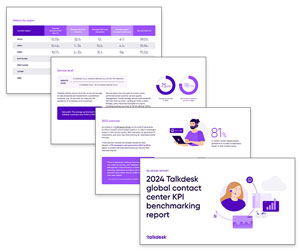In the first of a series of features looking at different types of technology, Robert Wint investigates the key components of quality monitoring, how the technology works, and what it can deliver.
What you should look for when purchasing quality monitoring
- Automatic delivery of calls – leaves supervisors free to focus on improving agent performance
- Contact management -makes it much easier to access recorded interactions that have been tagged and stored
- Contact recording – lets organisations capture, manage and learn from voice, web, chat and e-mail interactions
- Data recording – captures agent desktop activities to illustrate exactly which applications agents are using during an interaction
- Performance evaluation – customised forms, reports and graphs that facilitate the scoring of an agent’s performance
- KPI scorecards – role-appropriate scorecards that display actual predefined employee performance metrics
- Actionable learning – monitors quality monitoring scores and delivers targeted training to agents with specific skills requirements
- Speech analytics – analyses customer interactions and identifies each call that meets specific business criteria
- Comprehensive reporting – delivers intelligence to help contact centre supervisors and their managers make better informed decisions
What does quality monitoring technology actually do?
Quality monitoring is the process of listening to and observing a contact centre agent’s phone calls and other interactions, and then scoring those conversations against an agreed definition of what constitutes a great customer interaction.
Different approaches to measuring quality in a contact centre. One is an internal view that scores an agent’s recorded contact performance against a list of agreed quality attributes that are then scored and weighted. The other is to measure quality by going directly to the customers, either via e-mail, via the web or an interactive voice response (IVR) system, and asking customers for their own external view of an agent’s performance.Quality monitoring tools exist to increase the efficiency of these evaluation processes, reducing the amount of administrative effort involved in recording useful agent conversations, storing the recordings and scoring them for quality. The software helps to formalise and add substance to the definition of quality transactions, and also improve the workflow of key performance indicator (KPI) scorecards.
As quality monitoring develops so new capabilities such as monitoring the voice of the customer through feedback techniques, tracking workflow and root-cause analysis, and speech analytics are starting to deliver even greater capabilities.
How does quality monitoring technology work?
Traditional quality monitoring involves reviewing just a random sample of calls, assessing them for general quality standards, and then generating monthly reports based on average quality scores. Most companies only manage to evaluate less than one per cent of their calls this way.
However, some quality monitoring solutions can now combine call recording functionality with performance management, speech analytics and actionable learning capabilities. A single user interface allows supervisors to manage all aspects of quality monitoring, from the selection of recordings through call scoring, tracking and analysis against KPIs, and the automatic assigning and delivery of e-learning to agent desktops to address skills gaps.
Instead of simply scoring a small sample of selected evaluated calls, the more advanced QM implementations are now automatically prioritising calls based on key measures such as first contact resolution, successful or failed up-sell attempts, repeat or unresolved calls, even calls with poor or high customer satisfaction, so that limited QM resources can be focused on those areas where they are most needed.
In addition, contact centre management can drive best practice by turning the most successful customer interaction recordings in to e-learning content for other agents.
What kind of results can quality monitoring technology deliver?
Quality monitoring works best when it achieves a tangible link between quality measures and business results. This means measuring those aspects of an agent’s behaviour that are likely to have the most positive outcomes, such as customers spending more (and more often), using the optimum channels for your business, becoming more loyal and recommending your products and services.
So before even getting to the technology, contact centres need to get some buy-in as to which outcomes will make the most difference for their business. They then need to build the evaluation forms that will let them score agent performance in ways that actually matter.
The results can be impressive. I’ve found that effective quality monitoring programmes invariably result in sales conversion rates going up by at least 5% although there have been customers who have succeeded in doubling this performance.
The process of managing agents and using quality monitoring to feedback performance improvement can also have an impact on first time call resolution. Done right, it’s possible to see improvements of up to 10%, along with overall agent productivity improvements of up to 15%.
Contact centres that implement a technology-driven quality recording approach also usually see 50% improvement in team leader efficiency. Simply through not having to manually pick calls from tapes or spend time on side-by-side listening, team leaders free up a huge amount of time that they can spend on proper coaching, which in turn helps drive other improvements in the calls taken or made.
With potential results like this, it’s easy to see why organisations quickly gain a return on their investment in quality monitoring technology.
What other sorts of benefits can you expect with quality monitoring?
Quality monitoring is all about process improvement, and in addition to the initial gains organisations achieve through deployment, there’s an ongoing opportunity to secure continual incremental improvements. It’s essential for organisations to stick with their quality monitoring programmes, as once you’ve successfully baselined activities the gains keep on coming.
As call quality scores rise, you will invariably see a commensurate improvement in key business measures, from sales conversion rates through to improved customer retention. In turn, agents seem to benefit from working in a more efficiently managed environment, resulting in reduced attrition and falls in sickness and unscheduled absence.
Quality monitoring can also yield important insights in to activities that take place outside of the contact centre. Speech analytics techniques can be used to support sales by uncovering data relating to current campaigns or by identifying customer churn triggers, while the early capture of escalated calls to supervisors can alert the business to possible customer service issues.
Another key opportunity comes through the use of quality monitoring to highlight just why calls are coming in to the contact centre. If, for example a large number of calls relate to accounts issues, then effective root cause analysis can spot a repeat pattern and alert contact centre management who can then escalate the issue to the billing department.
It’s clear that quality monitoring, and its implementation within a wider workforce optimisation infrastructure, has the potential to be the most powerful tool that a contact centre can ever buy.

Robert Wint is EMEA marketing director at Verint Systems
Author: Jonty Pearce
Published On: 12th Oct 2007 - Last modified: 30th Jun 2022
Read more about - Technology, Headsets, Key Performance Indicators (KPIs), Quality


















I need a tips on how the contact center agents improvement method to be the best while interacting to customers and what they should do
What about live monitoring a call? Wouldn’t this provide more immediate feedback?
Live call onitoring does give immediate feedback, however there are a lot of variables that will depend on how effective it will be.
You have to take into account
– Is the advisor comfortable receiving feedback in front of their peers?
-Has the advisor been identified as soomone who may need a little more development than perhaps a more experienced advisor? If so coaching of the floor may be more appropriate.
-If you are coaching someone new to the company/team, a more formal approach may be needed to set out expectations and really disect the call to visit each part of the customer journey and ensure that if possible, a first call resolution was delivered.
So in essence, I feel that live call monitoring is more suited to your more experienced members of the team that maybe need a little less direction and whom you are confident delivers an excellent customer experience as ‘norm’.
IMHO, there should also be a measure of the quality of the environment in which the operatives are working as this impacts greatly on their overall performance and therefore customer satisfaction. For instance, do the telephone headsets comply with the 2006 Noise at Work Directive?
Live Call Monitoring is very effective however I have also experienced that letting an agent listen back to a recorded call is also very good. This lets them realize how they sound like towards the customer and can highlight a lot of aspects to improve on.
For example dead air or speech is more evident when listening back to call as to without a recording and just giving feedback.
Feedback does not always have to be given in front of others, it can also be done in a meeting room as I find it inappropriate for other peers to hear about that persons’ errors.
This is great but there should be a comprehensive checklist on how to monitor call centre agents for quality services,i.e quality performance.
This was a technology checklist – was it a quality monitoring form?
We have one of those here.
https://www.callcentrehelper.com/free-call-monitoring-form-3507.htm
How do I set a call centre up and what equipment do I need for four operatives
what equipment do i need to make four seperate phone calls.
Do I need four seperate phone lines.
Hi Chris
You would need more than 4 lines as you need extra lines for queuing. 6 – 8 lines would be a good idea. You also need a telephone system with ACD capability.